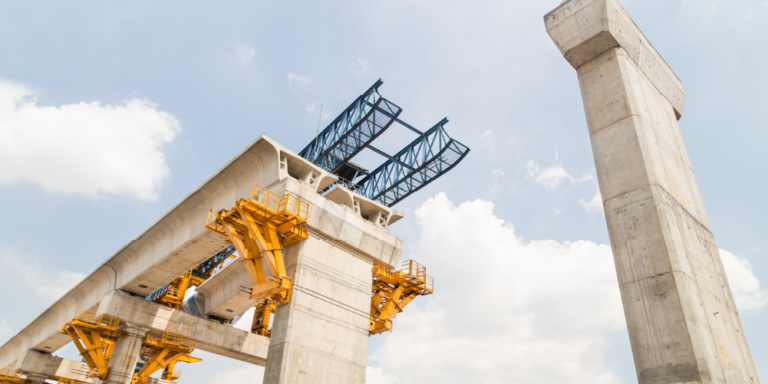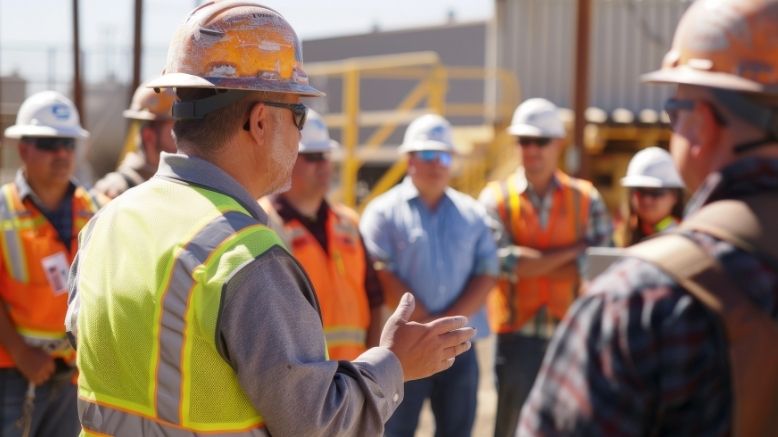— 8 min read
Spanning Success: The Unique Process of Bridge Construction


Last Updated Jun 26, 2024

Drew Olsen
Drew Olsen is a Civil and Infrastructure Account Executive at Procore. He brings more than 20 years of experience working in construction design and engineering. Drew holds a Bachelor of Science in Civil Engineering from the University of New Mexico. He is based in Albuquerque.

Larry Bernstein
Larry Bernstein is a freelance writer that specializes in construction and technology. He has written for Dodge Data & Analytics, Trimble, ENR, Bluebeam, and more. He holds a bachelor's degree in economics from Penn State University, a master's in secondary education from Brooklyn College, and a master's in creative writing and literature from Long Island University. He lives in New York.
Last Updated Jun 26, 2024

In the complex world of infrastructure development, the construction of bridges stands out for its unique set of challenges and requirements. As vital arteries that connect communities and facilitate commerce, bridges are marvels of modern engineering that require careful planning and adept execution.
The public agencies, engineers and contractors tasked with designing and delivering successful bridge projects need to work efficiently and collaborate closely. In this article, we explore some of the myriad ways bridge construction is unique — and what to consider at each phase of the project.
Learn more: What Makes Infrastructure Development Unique
Table of contents
The Phases of a Bridge Construction Project
Although bridge projects unfold in a series of distinct phases similar to any type of construction project, there are a number of unique considerations during each step.
Planning & Design
During predevelopment, collaboration between owners, designers, engineers and builders is crucial. One of the early decisions is the bridge type — whether a humble culvert or an audacious cable-stayed masterpiece — and is influenced by the demand for load capacity, cost constraints, and geographical considerations.
Broadly, there are seven types of bridges according to the engineering approach:
- Culverts: Simple structures under or beside roads for water drainage, preferred for their cost-effectiveness.
- Slab: Often concrete, with minimal design elements.
- Beam: Simple and affordable, often used for short spans.
- Cantilever: Supports long spans with minimal disruption to underlying traffic.
- Truss: An assembly of triangular units, creating a stable and efficient structure that distributes loads evenly across the framework. Popular for ease of assembly, often resulting in lower material and labor costs.
- Arch: Time-tested designs that span centuries, with tied-arch types being a combination of arch and suspension principles.
- Suspension/cable-stayed: Typically used for long spans over water, with distinctive towers and cables.
Aesthetic demands are another important consideration, especially for bridges that serve as urban landmarks or community gateways. A well-designed bridge often grows to serve as a symbol for the city or community in which it is built. Owners, engineers, contractors and architects all inevitably desire to create their own iconic stamp on the landscape.
Consider the selection process for a new bridge in a busy metropolitan center — it will differ substantially from that of a rural bridge designed to span a riverbed that floods seasonally. The metropolitan bridge must not only support heavy traffic but also blend with or enhance the cityscape, whereas the rural one might prioritize functionality and adaptability to seasonal changes.
Preconstruction
Once the type of bridge is selected, the challenges shift towards ensuring safe and efficient construction practices. Like any type of construction, the preconstruction phase of a bridge project involves the development of final design, estimates, securing budgets and the selection of the right contractor team for the scope of work.
This phase involves developing the bid package, known as Plans, Specifications, and Engineer’s Estimates (PS&E), a critical deliverable from the designer to the owner. The PS&E aims to provide clarity, establish contract control and set a uniform bidding basis on bridge and road construction projects.
Logistics
Preconstruction on a bridge project will also involve various logistical questions unique to infrastructure projects. In addition to the scope of work itself, bidding contractors will need to plan for unique logistical challenges, including:
- Component transportation: Logistics play a vital role, especially for large prefabricated components that require special transportation arrangements.
- Site accessibility: Ensuring that the construction site is accessible for workers and machinery without disrupting the surrounding environment or existing traffic.
- Technological integration: Leveraging technology for tasks like precision measurements, material quality testing, and real-time communication among teams.
- Traffic management: An integral part of bridge construction, especially in urban or populated areas, is the management of existing traffic.
Consider the logistics of constructing a bridge across a major waterway like the Mississippi River. Here, minimizing the number of piers in the water for environmental reasons might necessitate long-span steel girders. The transportation and assembly of these massive components can turn into a project in its own right, requiring specialized heavy-lifting equipment and potentially even temporary structures to support the construction process.
Stay updated on what’s happening in construction.
Subscribe to Blueprint, Procore’s free construction newsletter, to get content from industry experts delivered straight to your inbox.

Construction Phase
The physical construction of a bridge is a high-stakes endeavor for a variety of reasons. Workers face inherent dangers operating at height over water or active roadways. In addition, the material components and heavy equipment required to place them. Ensuring worker safety through meticulous planning and adherence to best practices is non-negotiable.
Furthermore, efficient project management is key to the timely completion of bridge projects. For example, when building a flyover ramp in a dense urban area, construction might have to proceed in stages to keep traffic flowing. This incremental approach requires a different set of strategies compared to a project with fewer constraints on access, such as a pedestrian bridge in a park setting.
Constructing a bridge is a detailed process that involves a series of critical steps. Whether over land or water, each phase is meticulously planned to ensure the structure's integrity and the safety of the public.
Foundation & Substructure
The foundation is the bedrock of the bridge—literally. For bridges over water, like the iconic Brooklyn Bridge, this step involves extensive underwater work, including the construction of cofferdams and the excavation of riverbeds to pour the foundation, often extending down to bedrock. Over land, this might entail the drilling of piers deep into the earth to ensure stability, particularly in areas with seismic activity.
Superstructure & Decking
Once the substructure is in place, the bridge's superstructure takes shape. For long-span bridges or those with heavy traffic loads, steel is often the material of choice due to its strength and flexibility. Concrete, a cost-effective and versatile option, is frequently used for beam or slab bridges. Complex projects like the Sunshine Skyway Bridge in Florida involve massive concrete and steel sections being floated into place on barges.
Routing & Traffic Management
The presence of ongoing traffic requires innovative solutions to minimize interruptions. This might involve building temporary bridges or bypasses. Alternatively, construction may be phased, opening a completed portion of the bridge to route traffic while other sections are constructed.
Deck Paving & Barrier Installation
With the girders, beams or arches in place, the deck is paved to create the driving surface. Here, a choice between asphalt and concrete must be made, often based on local climate conditions and maintenance considerations. Concurrently, barriers are erected for safety, and utilities are installed if the bridge includes provisions for water, gas, or electricity.
Final Inspections
Before the bridge opens to its first travelers, a series of rigorous inspections and load tests are performed to validate the design and build quality. These are often carried out by independent inspectors to ensure impartiality and adherence to the highest safety standards.
For example, the Millau Viaduct in France, the tallest bridge in the world, demanded meticulous inspections at every stage due to its height and the engineering complexity involved. It was opened to traffic only after a comprehensive review, marking the culmination of groundbreaking design and construction work.
Post-Construction & Asset Management
After construction, the remainder of the project involves thorough and regular inspections, finalizing as-built documentation and warranty management. Upon completion, the relevant state or federal asset management department takes ownership of the bridge.
Digital construction management tools now play a critical role in streamlining this phase. Ensuring efficient transfer of complete and accurate project data is crucial for ongoing bridge maintenance and management.
Legal & Regulatory Considerations
Bridge construction is not only an engineering endeavor; it's also a legal one. Every phase of the design and construction process is governed by a stringent regulatory framework to ensure safety, reliability and environmental stewardship. It is critical for every party to the project to thoroughly understand and comply with local and federal regulations.
Permitting & Environmental Regulations
Before breaking ground, bridge projects must secure the necessary permits from local, state, and federal authorities. This includes environmental assessments to comply with legislation such as the National Environmental Policy Act (NEPA), which mandates consideration of the potential impacts on the natural surroundings. For example, the construction of a bridge over a protected wetland would require careful study and planning to mitigate any ecological disturbances.
Design Standards & Codes
The design phase must adhere to established codes and standards, like the American Association of State Highway and Transportation Officials (AASHTO) guidelines, which set forth the criteria for structural design and materials. Compliance ensures that the bridge will support the loads it's expected to carry safely and durably. This level of scrutiny guarantees the longevity of grand structures like the Golden Gate Bridge, which not only meets but exceeds these rigorous standards.
Inspection & Quality Assurance
Regular inspections are an integral part of the bridge construction lifecycle. State Departments of Transportation (DOTs) often maintain their own inspection protocols, which may include examining the integrity of materials, the proper installation of components, and the overall workmanship.
These inspections occur at multiple stages:
- Prior to concrete pours or other foundation work
- During the installation of structural elements
- After the bridge is open to traffic
For instance, the construction of a suspension bridge requires specialized inspections for the cables and towers, ensuring their ability to withstand tension and compression forces over time. Likewise, the Federal Highway Administration (FHWA) mandates regular safety inspections of all public bridges to ensure they remain safe to use for the life span of the bridge, often 50 to 100 years.
Rising to the Challenge of Bridge Building
Bridge construction is a multifaceted process that demands a high degree of precision, ample planning, and stringent adherence to safety standards. The types of materials used, the method of construction, and the challenges posed by the surrounding environment all contribute to the intricate dance of building these essential structures.
Each bridge, upon completion, stands as a monument to human ingenuity and a testament to the tireless efforts of all who brought it to life. Owners and contractors alike must rise to the occasion, armed with best practices, a spirit of collaboration, and a keen eye on the evolving landscape of construction technology.
Was this article helpful?
Thank you for your submission.
86%
14%
You voted that this article was . Was this a mistake? If so, change your vote
Scroll less, learn more about construction.
Subscribe to The Blueprint, Procore’s construction newsletter, to get content from industry experts delivered straight to your inbox.
By clicking this button, you agree to our Privacy Notice and Terms of Service.
Thank you!
You’re signed up to receive The Blueprint newsletter from Procore. You can unsubscribe at any time.
Categories:
Written by

Drew Olsen
Drew Olsen is a Civil and Infrastructure Account Executive at Procore. He brings more than 20 years of experience working in construction design and engineering. Drew holds a Bachelor of Science in Civil Engineering from the University of New Mexico. He is based in Albuquerque.
View profile
Larry Bernstein
Larry Bernstein is a freelance writer that specializes in construction and technology. He has written for Dodge Data & Analytics, Trimble, ENR, Bluebeam, and more. He holds a bachelor's degree in economics from Penn State University, a master's in secondary education from Brooklyn College, and a master's in creative writing and literature from Long Island University. He lives in New York.
View profileExplore more helpful resources

Avoiding The App Trap: Overcome Financial Silos to Connect Field & Office
For general contractors working on razor-thin margins, rework and project delays are more than simple inefficiencies — they are major threats to the bottom line. For years, GCs have attempted...

Profit from Predictability: Construction Software as a Business Strategy
For general contractors, managing complex, multi-million-dollar projects, every project phase — from planning and budgeting to on-site execution — is an opportunity to lose time and money. Construction software is...

Defending Against Financial & Legal Risks on Megaprojects
The construction industry has seen marked growth in megaprojects. Some experts classify any project over $500 million as a megaproject, while others argue that the build needs to be $1...

Unlocking Project Intelligence: Moving from Raw Data to Actionable Insights
The construction industry faces a wide range of challenges, from ongoing labor shortages to frequent cost overruns. But some the biggest hurdles all stem from unpredictability. The general contractors (GCs)...
Free Tools
Calculators
Use our calculators to estimate the cost of construction materials for your next project.
Templates
Find a template to help you with your construction project tasks.
Material Price Tracker
Get the latest U.S. retail prices and view historical trends for common building materials.
Glossary
Explore key terms and phrases used in the industry.
